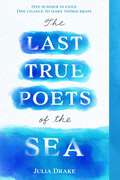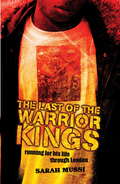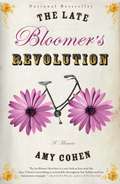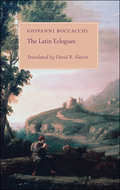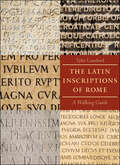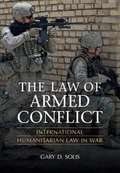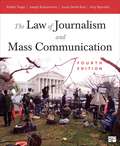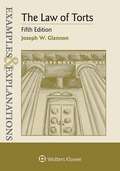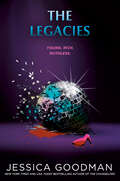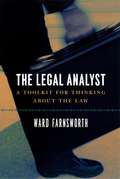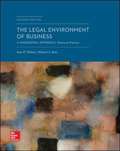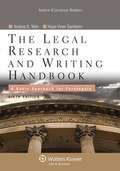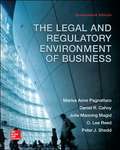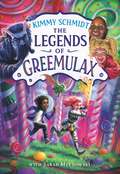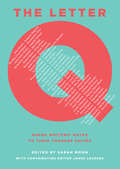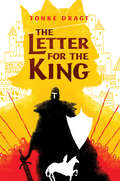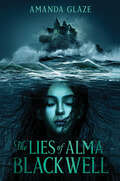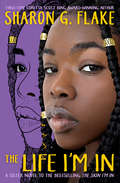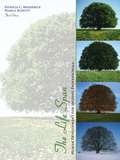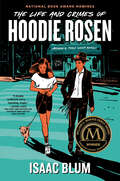- Table View
- List View
The Last True Poets of the Sea
by Julia DrakeFrom a new voice in YA literature comes an epic, utterly unforgettable contemporary novel about a lost shipwreck, a missing piece of family history, and weathering the storms of life. Fans of Far from the Tree, We Are Okay, and Emergency Contact will love this stunning debut."Profound and page-turning." --Madeline Miller, #1 New York Times best-selling author of CirceThe Larkin family isn't just lucky-they persevere. At least that's what Violet and her younger brother, Sam, were always told. When the Lyric sank off the coast of Maine, their great-great-great-grandmother didn't drown like the rest of the passengers. No, Fidelia swam to shore, fell in love, and founded Lyric, Maine, the town Violet and Sam returned to every summer. But wrecks seem to run in the family: Tall, funny, musical Violet can't stop partying with the wrong people. And, one beautiful summer day, brilliant, sensitive Sam attempts to take his own life. Shipped back to Lyric while Sam is in treatment, Violet is haunted by her family's missing piece-the lost shipwreck she and Sam dreamed of discovering when they were children. Desperate to make amends, Violet embarks on a wildly ambitious mission: locate the Lyric, lain hidden in a watery grave for over a century. She finds a fellow wreck hunter in Liv Stone, an amateur local historian whose sparkling intelligence and guarded gray eyes make Violet ache in an exhilarating new way. Whether or not they find the Lyric, the journey Violet takes-and the bridges she builds along the way-may be the start of something like survival. Epic, funny, and sweepingly romantic, The Last True Poets of the Sea is an astonishing debut about the strength it takes to swim up from a wreck.
The Last of the Warrior Kings
by Sarah MussiIt's a snowy evening, South London. From a bus, Max Wolf and his brother Angelo see a gang ominously tracking a well-known rapper, Mogul King, through the dark streets. Minutes later, Mogul King boards the bus, presses a parcel into Max's hands, exacts an incomprehensible promise, and jumps off again - to his death. The parcel contains an extraordinary ancient bronze dagger, and within hours Max is running for his own life through London, his brother, Angelo, is dead, apparently the victim of a gang drive-by shooting, and his friend, Sapphire, is next on the hit list.But everything is not as it seems. Everything leads the British Museum. Everything began with the ill-fated British Punitive Expedition of 1897 and the looting of the fabulous Benin Bronzes from Nigeria over a hundred years ago. In an intriguing dual storyline, Max's racing first person narrative story is offset by a scrap book of letters, memoirs, drawings, photos and journal entries, by one Hugh Hardy, Gunner aboard the Theseus, and foot soldier on that ruinous expedition over a century ago.
The Late Bloomer's Revolution: A Memoir
by Amy CohenThe debut of a sparkling and reassuring memoirist--an inspiration to late bloomers everywhere"I like to consider myself a late bloomer, meaning someone who will eventually, however late, come into bloom. Although when and if I will bloom remains a mystery. I wish I knew how to speak a foreign language fluently. I wish I knew how to cook a simple roast chicken, or that I had read The Idiot, whose main character sounds like someone I can relate to."In quick succession, Amy Cohen lost her job writing sitcoms, her boyfriend (with whom she'd been talking marriage), and her mom, after a long bout with cancer. Not exactly the stuff humor thrives on, is it? But filtered through Amy's worldview, there's comedy in the most unexpected places. In this unforgettable, engaging memoir, she recounts her (seemingly) never-ending search for love, her evolving relationship with her widowed dad, and her own almost unintentional growth as she stumbles through life.Filled with observations sweet, bittersweet, and laugh-out-loud funny, The Late Bloomer's Revolution will be irresistible to anyone who believes her greatest moment is yet to come.
The Latin Eclogues
by Giovanni BoccaccioGiovanni Boccaccio is famous for his masterpiece The Decameron, but his Latin Eclogues are relatively unknown. David R. Slavitt’s English translation makes these important pieces accessible to a new audience of readers. Elegant and engaging, these pastoral poems address the great issues of Boccaccio’s Italy, including the political and military intrigues of the day. Boccaccio modeled his poems on Petrarch’s eclogues and, before him, those of Virgil and Theocritus. Slavitt’s impeccable translations are highly readable, while his editorial interjections both elucidate the poet’s intended meaning and frame the poems for the reader. These charming works offer wonderful insight into daily life in Renaissance Italy. A prolific and award-winning translator, Slavitt turns the Eclogues into vibrant modern English, capturing not only the words of Boccaccio but the flavor of the original language.The availability of The Latin Eclogues in English is a major contribution to the study of the literature and history of the Italian Renaissance.
The Latin Inscriptions of Rome: A Walking Guide
by Tyler LansfordRome’s oldest known Latin inscription dates from the sixth century BC; the most recent major specimen was mounted in 2006—a span of more than two and a half millennia. Remarkably, many of these inscriptions are still to be found in situ, on the walls, gates, temples, obelisks, bridges, fountains, and churches of the city. Classicist Tyler Lansford has collected some 400 of these inscriptions and arranged them—with English translations—into fifteen walking tours that trace the physical and historical contours of the city. Each itinerary is prefaced by an in-depth introduction that provides a survey of the history and topography of the relevant area of the city. The Latin texts appear on the left-hand page with English translations on the right. The original texts are equipped with full linguistic annotation, and the translations are supplemented with historical and cultural notes that explain who mounted them and why.This unique guide will prove a fascinating and illuminating companion for both sophisticated visitors to the Eternal City and armchair travelers seeking a novel perspective into Rome's rich history.
The Law of Armed Conflict: International Humanitarian Law in War
by Gary D. SolisThe Law of Armed Conflict: International Humanitarian Law in War introduces law students and undergraduates to the law of war in an age of terrorism. What law of armed conflict/international humanitarian law applies to particular armed conflicts? Does that law apply to terrorists as well? What is the status of participants in an armed conflict? What constitutes a war crime? What is a lawful target and how are targeting decisions made? What are rules of engagement? What weapons are lawful and unlawful, and why? This text takes the reader through these essential questions of the law of armed conflict and international humanitarian law to an awareness of finer points of battlefield law. The U. S. -weighted text incorporates lessons from many nations and includes hundreds of cases from jurisdictions worldwide.
The Law of Journalism and Mass Communication (Fourth Edition)
by Amy L. Reynolds Joseph Russomanno Susan Dente Ross Robert TragerWith its clear and engaging writing, essential coverage and analysis, and substantive discussion of case law, this is a popular and comprehensive introduction to the law of journalism and mass communication. It includes: Photos and feature boxes, as well as a marginal glossary of legal terms and concepts Hypothetical cases which start each chapter and are then followed by a timeline showing landmark cases in context. Real World Law boxes illustrating contemporary examples and emerging topics Points of Law boxes underlining key points and legal tests. A student companion website to help aid review and study.
The Law of Torts: Examples and Explanations
by Joseph W. GlannonA favorite among successful students, and often recommended by professors, the unique Examples & Explanations series gives you extremely clear introductions to concepts followed by realistic examples that mirror those presented in the classroom throughout the semester. Use at the beginning and midway through the semester to deepen your understanding through clear explanations, corresponding hypothetical fact patterns, and analysis. Then use to study for finals by reviewing the hypotheticals as well as the structure and reasoning behind the accompanying analysis. Designed to complement your casebook, the trusted Examples & Explanations titles get right to the point in a conversational, often humorous style that helps you learn the material each step of the way and prepare for the exam at the end of the course. The unique, time-tested Examples & Explanations series is invaluable to teach yourself the subject from the first day of class until your last review before the final. Each guide: helps you learn new material by working through chapters that explain each topic in simple language challenges your understanding with hypotheticals similar to those presented in class provides valuable opportunity to study for the final by reviewing the hypotheticals as well as the structure and reasoning behind the corresponding analysis quickly gets to the point in conversational style laced with humor remains a favorite among law school students is often recommended by professors who encourage the use of study guides works with ALL the major casebooks, suits any class on a given topic provides an alternative perspective to help you understand your casebook and in-class lectures
The Legacies
by Jessica Goodman"Our new favorite thriller." – COSMOPOLITAN A glitzy YA thriller set in New York City elite social circles, filled with backstabbing and blackmail, twisty secrets, and a dead body, from New York Times bestselling author Jessica Goodman.Perfect for fans of Euphoria, Holly Jackson, and Jessica Knoll.An invitation for membership to the exclusive Legacy Club in New York City is more than an honor. It gives lifetime access to power and wealth beyond any prep school doors, as Legacy Club members always look out for their own. That is, after you make it through a rigorous week of events and the extravagant gala, the Legacy Ball.It&’s not surprising when Excelsior Prep seniors Bernie Kaplan, Isobel Rothcroft, and Skyler Hawkins are nominated as Legacies; their family pedigrees have assured their membership since birth—even if they're all keeping secrets that could destroy their reputations. But scholarship kid from Queens Tori Tasso is the surprise nominee no one saw coming. She&’s never fit in this world of designer bags, penthouse apartments, and million-dollar donations. So what did she do to secure her place?The evening of the Legacy Ball arrives, and everyone expects a night of luxury and excess, haute couture, and plenty of hushed gossip.No one expects their secrets to come out.Or for someone to die trying to keep them hidden.
The Legal Analyst: A Toolkit for Thinking about the Law
by Ward FarnsworthDrawing on economics, game theory, psychology, jurisprudence, and other fields. Ward Farnsworth's "The Legal Analyst" is a fascinating guide to tools for thinking about the law. Every idea is taught step-by-step, explained in clear, lively language, and illustrated with telling examples. The result is an indispensable book for law students, lawyers, scholars, and anyone else interested in legal questions.
The Legal Environment of Business
by Leonard Bierman Michael Pustay Keith D. Swim Jr.Impact of the external environment--legal, political, economic and international--on business behavior; market and non-market solutions to contemporary public policies confronting businesspersons examined including antitrust law, employment and discrimination law, product safety regulation, consumer, protection and ethics.
The Legal Environment of Business
by Michael Katz Sean MelvinThis textbook emphasizes bridging the gap between understanding legal doctrines that impact the business environment and how business owners and managers use legal insight to limit liability and manage risk. Its distinct approach focuses on using teaching features, simulations, case studies, examples, and case law that is accessible and engaging because it is specifically tailored for business students.
The Legal Environment of Business: Student Study Guide (6th Edition Revised)
by Keith D. Swim Jr.Impact of the external environment--legal, political, economic and international--on business behavior; market and non-market solutions to contemporary public policies confronting businesspersons examined including antitrust law, employment and discrimination law, product safety regulation, consumer, protection and ethics.
The Legal Research and Writing Handbook: A Basic Approach for Paralegals (6th Edition)
by Andrea B. Yelin Hope Viner SambornThe highly successful textbook on research and writing makes every step of the process accessible to paralegal students. The authors provide effective research tools, practical strategies and an efficient procedure for researching the law with both traditional and electronic sources. Step-by-step instruction leads students through each stage of activity, from prewriting to revising, and covers the IRAC method, legal memoranda, letters, and more. Invaluable pedagogy features examples, exhibits, expert writing tips,exercises, practice tips, ethics alerts, and web resources. Detailed subheadings provide quick access to topics, and appendices on helpful topics such as Shepardizing and Cite Checking, Citation and Sample Memoranda round out the presentation. The Student Workbook provides for extensive practice,sharpening research and writing skills. Thoroughly revised, the Sixth Edition presents new sample pages and updated exercises. Citation coverage has been updated to the 4th edition of ALWD and the 19th edition of The Bluebook . Inclusion of all the latest changes in legal research led to the revision of references, links, and examples. Students are now given more coaching on the practical aspects of outlining. The Instructor's Manual has expanded explanations, and answers to exercises and questions have been made clearer and more accessible. Hallmark features of The Legal Research and Writing Handbook:Accessible coverage of every step of the research and writing process Research tools and strategies teach an efficient process cover traditional and electronic sources Step-by-step instruction in legal writing process prewriting strategies to revising the IRAC method legal memoranda, letters, and more Excellent pedagogy examples and exhibits expert writing tips exercises practice tips ethics alerts web resources Detailed subheadings for quick access to topics Helpful appendices Shepardizing and Cite Checking Citation Sample Memoranda Student Workbook-extensive practice in research and writing skills ; Thoroughly updated, the revised Sixth Edition presents:New sample pages Citation coverage updated to 4th edition of ALWD and 19th edition of The Bluebook Latest changes in legal research Revised and updated material throughout:references links examples exercises More detail on practical aspects of outlining Thorough revision of the Instructor's Manual expanded explanations cogent and accessible answers to exercises and questions*Instructor's Manuals are a professional courtesy offered to professors only. For more information or to request a copy, please contact Wolter's Kluwer Law & Business at 800.529.7545 or examcopy@wolterskluwer.com.
The Legal Research and Writing Workbook: A Basic Approach for Paralegals (6th Edition)
by Andrea B. Yelin Hope Viner SambornProviding effective research tools, practical strategies and an efficient procedure for researching the law with both traditional and electronic sources, this textbook on research and writing makes every step of the process accessible to paralegal students. Step-by-step instruction leads students through each stage of activity, from prewriting to revising, and covers the IRAC method, legal memoranda, letters, and more.
The Legal and Ethical Environment of Business
by Lisa Johnson Terence LauTerence Lau & Lisa Johnson's The Legal and Ethical Environment of Business is a book for today's student, who expects learning to be comprised not only of substance, but also of interactive exercises and multimedia. This book streamlines the presentation of material to ensure that every page is relevant, engaging, and interesting to undergraduate business students, without losing the depth of coverage that they need to be successful in their academic journeys and in their professional careers. This is not Legal Environment of Business (LEB) "light." Rather, this is LEB without risk of students' eyes glazing over in boredom or from lack of comprehension. This is LEB presented in an exciting way, where every page is interesting to students and relevant to real life.
The Legal and Regulatory Environment of Business (Seventeenth Edition)
by Marisa Anne Pagnattaro Daniel R. Cahoy Julie Manning Magid O. Lee Reed Peter J. SheddUsing court cases and examples in Sidebars that are relevant for business, we underscore how learning about the law is essential to understand how the law can be used for strategic advantage and how to develop sustainable business practices.
The Legend of Sleepy Hollow and Other Stories (Union Square Kids Unabridged Classics)
by Washington IrvingWashington Irvings haunting, macabre stories will give wide-eyed young readers delightful chills. This spooky anthology of timeless tales includes “The Legend of Sleepy Hollow,” the eerie “Rip Van Winkle,” the funny “The Specter Bridegroom,” and “The Devil and Tom Walker.” Its perfect for Halloween, campfires, or anytime kids want a fun scare!
The Legends of Greemulax
by Kimmy Schmidtp.p1 {margin: 0.0px 0.0px 0.0px 0.0px; font: 16.0px 'Times New Roman'} span.s1 {font: 11.0px Cambria} Following in the tradition of J. K. Rowling and Roald Dahl, Kimmy Schmidt is an exciting new voice in middle-grade fantasy adventure. This debut will change the way boys and girls everywhere see the world -- and each other! p.p1 {margin: 0.0px 0.0px 0.0px 0.0px; font: 16.0px 'Times New Roman'} p.p2 {margin: 0.0px 0.0px 0.0px 0.0px; text-indent: 48.0px; font: 16.0px 'Times New Roman'} span.s1 {font: 11.0px Cambria} Penn dreads the day that he will start to become a monster, but it's inevitable. The youngest of his tribe in Greemulax, he knows that as boys become men, they turn into powerful, hairy blue creatures called Grabagorns, and that their solemn vow is to never again be weak. Legend has it that dragons all but destroyed Greemulax years ago during a terrible time known as the Great Scorch. Not one of the tight-knit community's girls or women survived, and the men, ruled by Grabagorn Prime, have lived in mourning and anger ever since. But when one of Penn's dragon traps catches a real live girl named Kristy, he starts to question everything he thought was true.Together, Penn and Kristy set off on an adventure that will take them to a tugboat in a tree and through a treacherous lake of pudding, toward a candy forest guarded by dragons that might hold the answers they seek. The more time they spend with each other, however, the faster Penn transforms into the monster he fears, and the more Kristy seems to fade away into nothing. Can they reach their destination before it's too late?In recognition of this book's release, NBCUniversal is making a donation in support of Prevent Child Abuse America. p.p1 {margin: 0.0px 0.0px 0.0px 0.0px; font: 15.0px Calibri} span.s1 {color: #ff2500}
The Letter Q: Queer Writers' Notes to Their Younger Selves
by James Lecesne Sarah MoonLife-saving letters from a glittering wishlist of top authors.If you received a letter from your older self, what do you think it would say? What do you wish it would say?That the boy you were crushing on in History turns out to be gay too, and that you become boyfriends in college? That the bully who is making your life miserable will one day become so insignificant that you won't remember his name until he shows up at your book signing?In this anthology, sixty-three award-winning authors such as Michael Cunningham, Amy Bloom, Jacqueline Woodson, Gregory Maguire, David Levithan, and Armistead Maupin make imaginative journeys into their pasts, telling their younger selves what they would have liked to know then about their lives as Lesbian, Gay, Bisexual, or Transgendered people. Through stories, in pictures, with bracing honesty, these are words of love and understanding, reasons to hold on for the better future ahead. They will tell you things about your favorite authors that you never knew before. And they will tell you about yourself.
The Letter for the King
by Tonke DragtThe thrilling story of one boy's battle against evil set in an enchanted world of chivalry, courage, and true friendshipSixteen-year-old Tiuri must spend hours locked in a chapel in silent contemplation if he is to be knighted the next day. But as he waits by the light of a flickering candle, he hears a knock at the door and a voice desperately asking for help.A secret letter must be delivered to King Unauwen across the Great Mountains--a letter upon which the fate of the entire kingdom depends. Tiuri has a vital role to play, one that might cost him his knighthood. He must trust no one. He must keep his true identity secret. Above all, he must never reveal what is in the letter . . .Tiuri's journey will take him through dark, menacing forests, across treacherous rivers, to sinister castles and strange cities. He will encounter evil enemies who would kill to get the letter, but also the best of friends in the most unexpected places.
The Lies of Alma Blackwell
by Amanda GlazeAtmospheric and sweepingly romantic, this gothic YA mystery tells the story of a girl poised to inherit a famously haunted California mansion and a stranger who arrives with a dark warning... For over a century, the Blackwells have protected the town of Hollow Cliff from vengeful spirits. Seventeen-year-old Nev is ready to take over for her ailing grandmother as the town&’s witch protector—unlike her mother, who left when Nev was a child and never looked back. When a stranger arrives at Blackwell House of Spirits to fill a tour guide opening, Nev reluctantly offers him the job. Nev doesn&’t trust Cal. He knows more than he&’s letting on about Blackwell House—and about Nev herself. But Nev soon learns that she has been lied to her whole life. By following the trail of clues left behind in Blackwell House by her most powerful witch ancestor, Nev uncovers an unspeakable legacy of murder and lies...and realizes that a stranger may be the one person she can trust. Perfect for readers seeking captivating fantasy books for teens, The Lies of Alma Blackwell offers a thrilling journey into the supernatural that will appeal to fans of House of Salt and Sorrows, The Bone Witch, and other young adult books about magic, family drama and ghostly intrigue. With its unique blend of mystery, romance, and paranormal elements, this YA fantasy book promises to keep readers on the edge of their seats until the very last page.
The Life I'm In
by Sharon G. FlakeThe powerful and long-anticipated companion to The Skin I'm In, Sharon Flake's bestselling modern classic, presents the unflinching story of Char, a young woman trapped in the underworld of human trafficking.My feet are heavy as stones when I walk up the block wondering why I can't find my old self.In The Skin I'm In, readers saw into the life of Maleeka Madison, a teen who suffered from the ridicule she received because of her dark skin color. For decades fans have wanted to know the fate of the bully who made Maleeka's life miserable, Char.Now in Sharon Flake's latest and unflinching novel, The Life I'm In, we follow Charlese Jones, who, with her raw, blistering voice speaks the truths many girls face, offering insight to some of the causes and conditions that make a bully. Turned out of the only home she has known, Char boards a bus to nowhere where she is lured into the dangerous web of human trafficking. Much is revealed behind the complex system of men who take advantage of vulnerable teens in the underbelly of society. While Char might be frightened, she remains strong and determined to bring herself and her fellow victims out of the dark and back into the light, reminding us why compassion is a powerful cure to the ills of the world.Sharon Flake's bestselling, Coretta Scott King Award-winning novel The Skin I'm In was a game changer when it was first published more than twenty years ago. It redefined young adult literature by presenting characters, voices, and real-world experiences that had not been fully seen. Now Flake offers readers another timely and radical story of a girl on the brink and how her choices will lead her to either fall, or fly.
The Life Span: Human Development for Helping Professionals (Third Edition)
by Patricia C. Broderick Pamela BlewittBased on extensive research, the book effectively provides an array of information about principles of human development from birth to death.
The Life and Crimes of Hoodie Rosen
by Isaac BlumLONGLISTED FOR THE NATIONAL BOOK AWARD!A WILLIAM C. MORRIS AWARD WINNER!The Chosen meets Adam Silvera in this irreverent and timely story of worlds colliding in friendship, betrayal, and the hatred that divides us.Hoodie Rosen's life isn't that bad. Sure, his entire Orthodox Jewish community has just picked up and moved to the quiet, mostly non-Jewish town of Tregaron, but Hoodie's world hasn't changed that much. He's got basketball to play, studies to avoid, and a supermarket full of delicious kosher snacks to eat. The people of Tregaron aren&’t happy that so many Orthodox Jews are moving in at once, but that&’s not Hoodie&’s problem.That is, until he meets and falls for Anna-Marie Diaz-O&’Leary—who happens to be the daughter of the obstinate mayor trying to keep Hoodie&’s community out of the town. And things only get more complicated when Tregaron is struck by a series of antisemitic crimes that quickly escalate to deadly violence.As his community turns on him for siding with the enemy, Hoodie finds himself caught between his first love and the only world he&’s ever known.Isaac Blum delivers a wry, witty debut novel about a deeply important and timely subject, in a story of hatred and betrayal—and the friendships we find in the most unexpected places.Praise for The Life and Crimes of Hoodie Rosen:&“A deeply authentic story about the terror and glory of encountering the outside world without sacrificing who you are—and who you want to be. It&’s touching, tragic, and as Jewish as your Bubbe&’s cholent.&” –Gavriel Savit, New York Times bestselling author of Anna and the Swallow Man&“Blum gives the common but often-dismissed spiritual journey of many teens the respect it deserves in this witty, profound look at cross-cultural friendship, courageous honesty, and how a willingness to truly see and love our neighbors can change an entire community.&” –Vesper Stamper, National Book Award-nominated author of What the Night Sings&“A refreshingly human look at the day-to-day nuances of Orthodox Judaism and the terror of modern antisemitism. I laughed, I gasped, I craved kosher Starburst. Two thumbs up from this nice Jewish girl!&” –Tyler Feder, Sydney Taylor Award-winning author of Dancing at the Pity Party&“Bold, brave, and brutally honest, it holds a permanent piece of my heart.&” –Dahlia Adler, author of Cool for the Summer"Isaac Blum has the rare talent of telling searing, visceral truths in a witty, funny, punchy way . . . The Life and Crimes of Hoodie Rosen is a vital voice in Jewish YA canon." –Katherine Locke, Sydney Taylor Honor author of The Girl with the Red Balloon
